Page contents
ToggleHow to achieve a scientific state of the art
Most scientific ideas don't just materialize out of thin air. They build on theories, methods and findings found or developed in previous work. It is appropriate to carry out a scientific state of the art once you have determined the problematic.
Here is the famous quote used by Google Scholar:
“We are like dwarves perched on the shoulders of giants (the Ancients), so that we can see more things and more distant things than the latter saw. And this, not because our eyesight is powerful or our size advantageous, but because we are carried and elevated by the tall stature of the giants.”
12th century, Bernard of Chartres
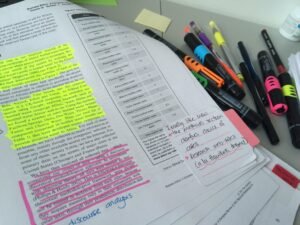
Why take a state of the art?
A literature review is a selection and analysis of existing research that is relevant to your topic. It shows how your work relates to previous research.
You demonstrate the ability to understand and critically analyze the research background and select and find the information needed to develop a context for your work.
Concretely: Am I the first to have this idea? Which aspect of my discovery is new and which is not? Has anyone else had a similar idea? What are the results and the conclusions of other similar ideas? Etc.
Only a bibliographic study allows you to convince people of the contribution of your new idea / discovery / theory / method in the field. For example. solve a previously unsolved problem, fill a gap, generalize an existing theory
How to structure your state of the art
A literature review is not a simple summary from everything you've read on the subject. Nor is it a chronological description of what has been discovered in your field. A common way to approach a literature review is to start broad and then get more specific.
To handle a large number of related works, group similar works according to, for example, commonly used theories, methods, system properties, etc.
This will help compare and contrast their approaches and make it easier to discuss the literature in preparation for your new idea. Be careful and specific in rejecting related work when promoting your idea.
A common way to approach a literature review is to start broad and then get more specific.
- First briefly explain the major questions related to your work. You don't needto write a lot about it, just show that you are aware of the breadth of your topic
- Next, focus on articles that overlap with your search
- Finally, focus on research that is closely related to your specific work. Proportionately, you spend the most time discussing these documents
Before starting its state of the art
Before starting to dive into the literature review, it is important to ask yourself the right questions:
- Identify what you need to know:
- What research has already been done on my topic?
- What are the relevant subfields of my topic?
- What are the key articles on my topic?
- What are the key issues, types of research questions and common approaches?
- What other research (perhaps not directly on the topic) or other research communities might be relevant?
- moreover
- Which research community is relevant to my topic?
- What are the relevant publication venues (top conferences and journals) in this community?
- Who are the important authors?
There are many sites for carrying out scientific bibliographic research. Here are the best known.
- Google Scholar, Microsoft Academics, CiteSeer, OpenEdition
- With subscription from your university: Web of Science, ACM Digital Library, IEEE Digital Library
- Beware of illegal sites like Sci-Hub (researchers can send you their paper on request, don't hesitate to send them emails)!
Algorithm to achieve the state of the art
If you don't know where to start, follow the following algorithm:
- Access a university search engine
- Use well-chosen keywords to find five recent articles in the field (“seed” articles).
- Select all five articles based on summary and keyword match
- Prefer journal articles, then conference articles. Skip the manuals
- As you read the summaries and titles, refine your keywords and iterate
- Read the related work section of each article
- You will find a summary of recent work in your region
- If you're lucky, you'll find pointers to a recent survey article
- Find shared citations, repeated author names, and publication locations in bibliographies
- These are probably the important articles, authors and places in this field
- Maintain statistics of their occurrences
- Download these papers and put them aside
- Go to the key researchers' website or Google Scholar profile and see what they've published recently and where they've published it
- This will help you identify the best journals and conferences in this field, because the best researchers generally publish in the best places.
- This will also give you high quality newer related works
- Download and save the most relevant articles
- Go to the websites of these journals and conferences and browse their recent issues/proceedings
- This will give you high quality newer related work
- Download and save the most relevant articles
- Use an academic search engine to find recent articles that cite the important articles found in step 4 (click on the citation count)
- Download and save the most relevant articles
- All the papers you have set aside constitute the first version of your investigation
- Go to step 3, repeat if necessary
- A good criterion for stopping is when the statistics on important author names, publication locations, and articles have roughly converged
Here is an image of the algorithm:
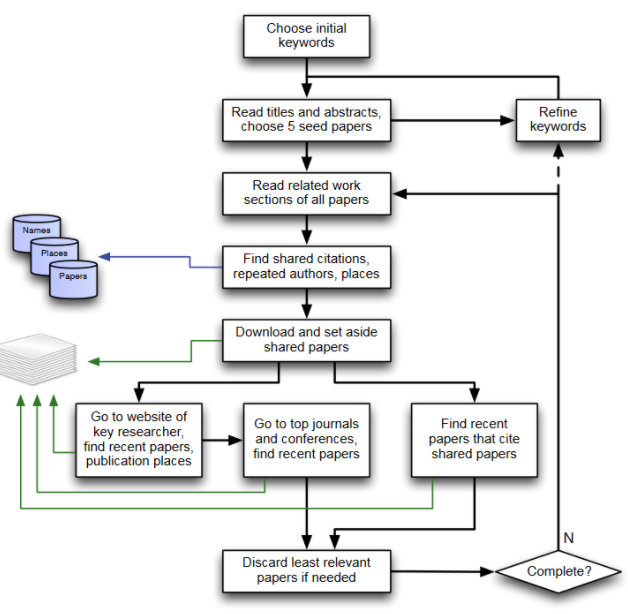
Choose the right papers to read
When conducting a literature review, the number of citations to an article or author is a good heuristic for finding important articles and authors.
Yet:
- Very recent articles have not had time to accumulate many citations
- Young (but promising) researchers rarely have many citations
- Sometimes a great article goes uncited because it is ahead of its time, proposes an uncommon idea against the current mainstream, or other reasons for human error
When you choose a paper, it should be able to answer one of the following questions:
- What is the research problem addressed in the article?
- Why is this problem important?
- What are the innovative ideas and key concepts proposed by the authors?
- What is the relationship between paper and other papers?
- What is the main contribution of the article?
- Are there any concepts or methods in the document that are unclear?
- What are the flaws or limitations of this article?
- How would you extend this work?
How to organize your state of the art
Now that you have read several references relating directly or indirectly to your subject and problem, it is important to organize yourself well in order to put on paper the mass of information that you will have to digest. Here's how to organize your state of the art.
organize your state of the art
The structure of a literature review should include the following elements:
- An overview of the topic, question or theory under study, as well as the objectives of the literature review,
- Division of the works examined into themes or categories [e.g. works that support a particular position, those that are against it, and those that propose entirely alternative approaches],
- An explanation of the similarity and difference of each work compared to the others,
- The conclusions regarding the elements best taken into account in their argument, are the most convincing of their opinions and make the greatest contribution to the understanding and development of their field of research.
The four steps to follow to organize your state of the art
Everything in research follows a protocol or scientific method. The state of the art is no exception to the rule. Here are the four steps to properly structuring your state of the art:
- Problem formulation: what subject or area is being examined and what are its constituent issues?
- Documentary research: find documents relevant to the subject explored.
- Data Evaluation: Determine which literature makes a significant contribution to the understanding of the topic.
- Analysis and interpretation: discuss results and conclusions from relevant literature.
To do this, you must follow the algorithm described in the previous course. The more paper you have read and synthesized (the next course), the more material you will have. However, it quickly becomes complicated to know what to keep.
The narrower your topic, the easier it will be to limit the number of sources you read to get a good overview of relevant resources. Your professor probably won't expect you to read everything available on the topic, but you will make your work easier if you first limit the scope of the research problem (see the problem courses).
If your assignment is not very specific about what form your literature review should take, ask your professor for clarification by asking these questions:
- Approximately how many sources should I include?
- What types of sources should I consult (books, journal articles, websites; scholarly sources or popular sources)?
- Should I summarize, synthesize, or critique the sources by discussing a common theme or issue?
- Should I evaluate the sources?
- Do I need to provide subtitles and other contextual information, such as definitions and/or history?
Chronological, thematic or methodological? What strategy to organize your state of the art
There is no single way to organize your readings; you can combine ways or reorganize yourself as you go along.
One way to organize readings is to understand trends from a chronological perspective. If your state of the art follows the chronological method, you can write about documents according to their publication date.
This approach should only be followed if a clear path of research building on previous research can be identified and if these trends follow a clear chronological order of development. Order your sources by publication chronology, and then only if the order demonstrates a larger trend.

It is also possible to organize by theme, often, the themes are trends visible chronologically. Thematic literature reviews are organized around a topic or question, rather than the progression of time. However, progression over time can still be an important factor in a thematic review.
The only difference here between a “chronological” approach and a “thematic” approach is what is most emphasized. Note, however, that thematic reviews are more authentic and may break with chronological order. An exam organized in this manner would move from one period to the next within each section depending on the point being made.

The last approach is methodological. A methodological approach focuses on the methods used. A methodological scope will influence either the types of documents in the review or the manner in which these documents are discussed.
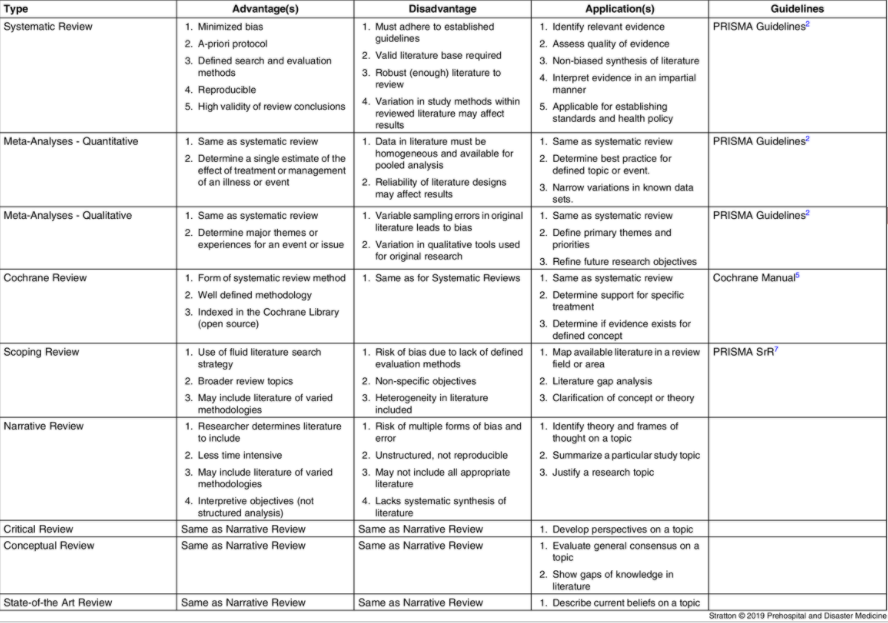
Make your first summaries
Once you have decided how to organize your literature review, you are ready to write each section. When writing your review, keep these questions in mind. The next two courses will help you read the papers quickly and structure your state of the art.
A literature review section is, in this sense, like any other academic research paper. Your interpretation of available sources must be supported by evidence [citations] that demonstrates that what you say is valid. To organize your state of the art, it is important to always reference the writings when taking notes.
Select only the most important points in each source to highlight in the review. The type of information you choose to mention should be directly related to the research problem, whether thematic, methodological, or chronological. Related items that provide additional information but are not essential to understanding the research problem can be included in a further reading list.
A few short quotes are acceptable if you want to emphasize a point or if what an author said cannot be easily paraphrased. Sometimes you may need to cite terminology invented by the author, not commonly known, or taken directly from the study. Do not use lengthy quotations to replace your own summary and interpretation of the literature.
Remember to summarize and synthesize your sources in each topic paragraph as well as throughout the review. Summarize the important features of a research study, then synthesize them by restating the importance of the study and relating it to your own work.
While the literature review presents the ideas of others, your [the writer's] voice should remain at the forefront. For example, incorporate references to other sources into what you write, but maintain your own voice by starting and ending the paragraph with your own ideas and wording.
When paraphrasing a source that is not your own, be sure to represent the author's information or opinions accurately and in your own words. Even when you paraphrase an author's work, you should still provide a citation to that work.
Why make a concept map?
When new knowledge is integrated and connected to existing knowledge, this new knowledge is easier to understand and map.
Concept map is defined as:
- A network of interconnected concepts
- Good for knowledge map and content gap analysis
- Mapping for tacit knowledge and content that has many-to-many relationships
- More logical
- Verifiable due to its connection words
- Difficult to modify if more than 20 nodes
The concept mapping (webbing) technique was developed by Dr. Joseph D. Novak of Cornell University. He defines concept maps as graphical tools for organizing and representing knowledge. They include concepts, also called nodes, and relationships between concepts indicated by a line and words on the line. The words on the front are linking words or linking phrases.
Simply put, the concept map is a network of interconnected concepts. Novak's team has several suggestions for creating a decent concept map.
See the XMind tutorial or the dedicated course on our site: https://www.xmind.net/blog/en/concept-map-tutorial/
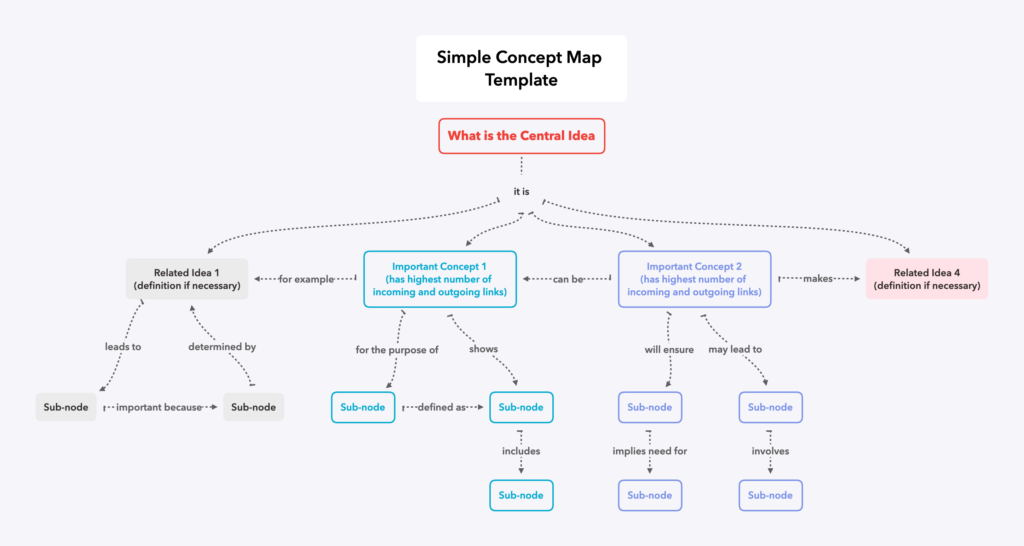
A concept map is a visual presentation of information and details. Concept maps can have different designs such as tables, charts, graphic designs, flowcharts and Venn diagrams. Using concept maps is an effective learning strategy since concept maps visually demonstrate facts. So, it will help students to memorize the facts easily.
Additionally, concept maps provide students with the opportunity to understand relationships more clearly. Concept maps can also be used to analyze information and compare and contrast it. Ideas and related relationships are clearly demonstrated in concept maps. For example, we can demonstrate the process of making yogurt using concept maps, especially using a flowchart.
This strategy of using a concept map not only works for school learners, but also helps adults in the workplace understand different topics and relationships. Concept maps help encourage brainstorming and high-level thinking. At the same time, it gives clear communication of complex ideas.
Why make a mind map?
Mind map is defined as:
- A tree to organize information
- Ideal for brainstorming, idea generation and quick note-taking
- For nodes that have simple, mostly one-to-one relationships
- More flexible
- Not verifiable
- Easy to edit even for large maps
The term Mind Mapping was first developed and popularized by psychology author Tony Buzan in the 1970s. The definition of mind mapping is:
A mind map is a diagram used to visually organize information. A mind map is hierarchical and shows the relationships between the elements of the whole.
Simply put, the mind map is a tree for organizing information. Buzan suggested that all mind maps should have only one central topic. The main ideas connect directly to this topic and the child topics derive from the main ones.
See the XMind tutorial: https://www.xmind.net/blog/en/concept-map-tutorial/

A mind map is a diagram that presents related ideas and perceptions of a central concept or topic. This is a non-linear graphical presentation. Mind maps can be used as colorful, organized diagrams to present data.
When information has structure, it helps to understand and analyze data more clearly. Additionally, mind maps help generate and recall new data and ideas. Since mind mapping is different from traditional note-taking, it requires both analytical skills and artistic skills.
Mind maps are unique from person to person. We can use mind maps for different purposes such as note-taking, brainstorming, problem-solving, studying, planning, and presenting information. There are some techniques and tips that we can follow to draw mind maps. Using colors and images in drawing mind maps helps stimulate the visual ability of the brain.
At the same time, mind maps help to remember things more easily when keywords are used instead of sentences in the diagram. At the same time, codes, symbols and arrows can be used to designate connections between ideas. We should always revisit a mind map after the first attempt to check the clarity of the diagram. Additionally, users can use their own mind map designs to make them more attractive and beautiful.
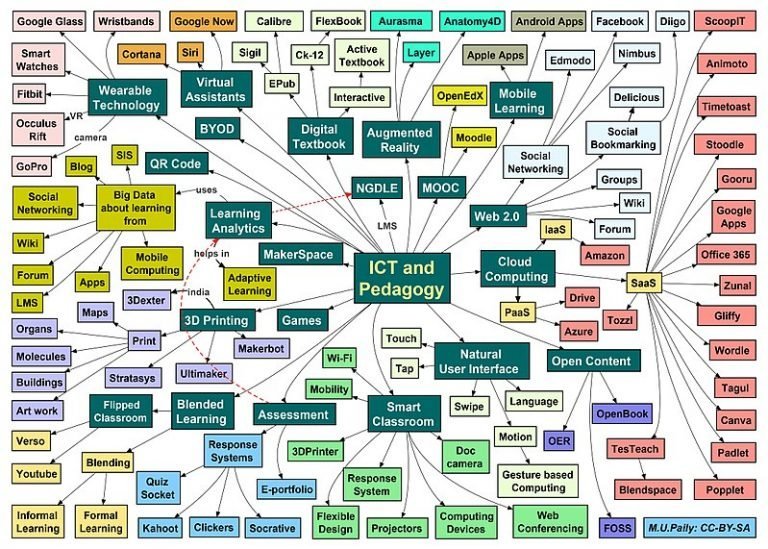
Benefits of the Concept Map
Benefits
- Less ambiguity for the public.
- Great for displaying tacit knowledge. Tacit knowledge is difficult to write down or verbalize explicitly, like some consensual or mental models of a business.
- Able to model fundamental knowledge.
- Useful for content gap analysis. Researchers have found that networking concepts is beneficial for identifying research gaps. But to do this best, you need the help of data analysis tools.
The inconvenients
- Unfriendly to collaboration. Due to its high learning curve and the complexity of the rules.
- Hard to do. The lines overlap. Connections are complicated. Plus, you have to organize them!
- Low readability. When you have more than 20 nodes it's even worse.
Benefits of Mind Map
Benefits
- Adaptable to academic and commercial environments.
- Useful for brainstorming. All you focus on is posting topics.
- Easy to do. Low learning curve. No complicated many-to-many relationships, just trees.
- Flexible to change (in mind-mapping software). Connections and layout are generated automatically. And you can attach or detach topics with simple drag and drop. Mind maps are capable of constant updates.
- Easier to read. No jumping from one corner of the paper to the other.
The inconvenients
- No more ambiguities for the public. Due to lack of linking phrases.
- Incompetent at articulating tacit knowledge. Due to the lack of linking phrases and simple relationships.
- Not suitable for in-depth analysis. Mind maps make you less likely to take a deep look at the concepts listed. Well, the comparison is over, now it’s time to make a choice!
Mental or conceptual map?
Concept maps seem more complicated, while mind maps are essentially trees. They focus differently on different elements.
The concept map values both topics and connections. While mind maps look more at the subject themselves. This is why, if you look closely, you think that concept maps explain more clearly why certain nodes are connected. On the other hand, when you just want to write down as many topics and information as possible, mind mapping is a better option.
Topics in the concept map can be linked together. But mind map topics can't. So you can show many-to-many relationships in mind mapping.
Each proposal in concept maps is a statement. Whereas mind mapping does not involve the concept of proposition. In concept maps, every two connected nodes and their linking phrases form a sentence. For example, “Subject A includes subject B” is a proposition. So you can read and check the map.
Because of their similarities and different benefits, people naturally mix them into one card.